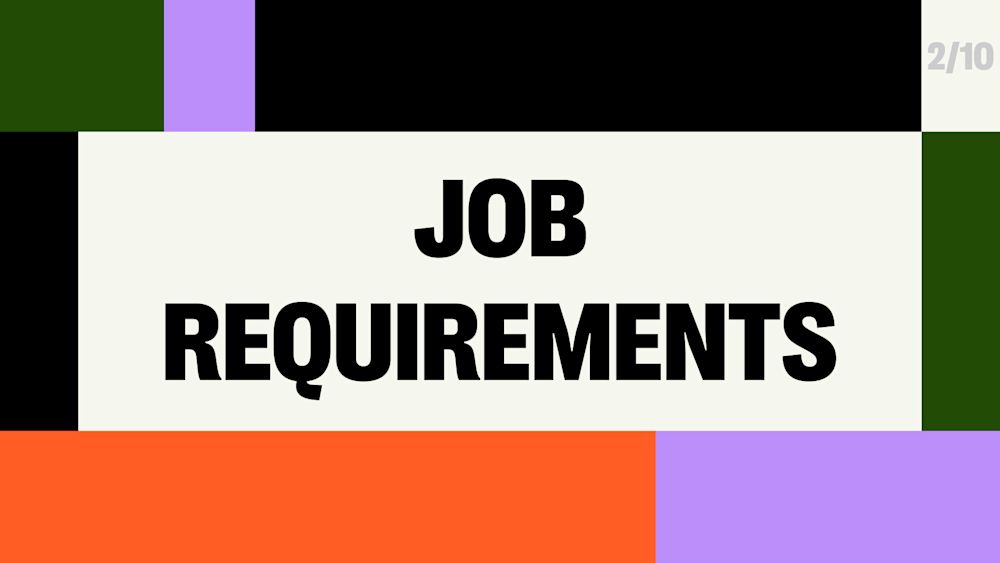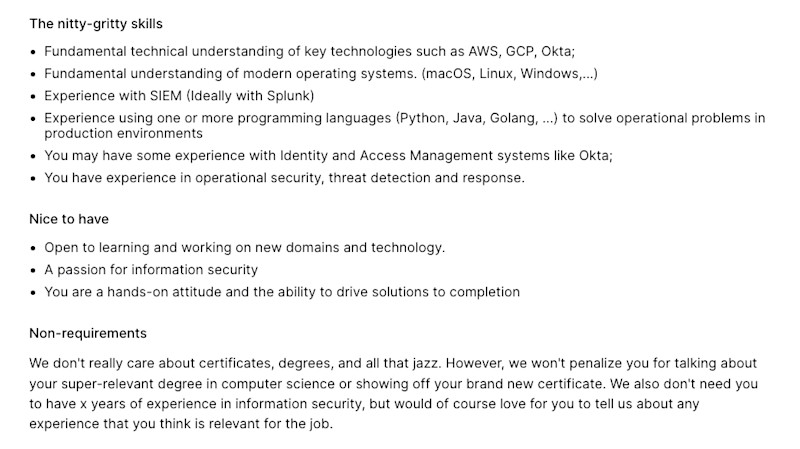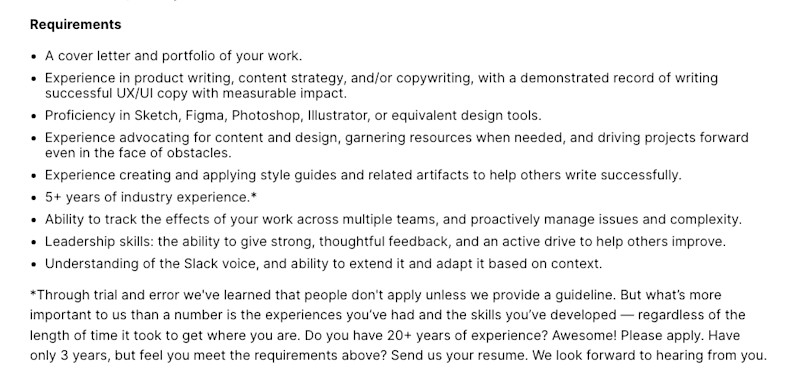How to Write Job Requirements to Attract the Best Talent
Table of contents
Your org is ready to recruit. That means it’s time to create a job posting — and one of the most important things to include is a list of job requirements. Clearly defining what qualifications you’re looking for in a candidate is the best way to attract the right people and ensure that you get the best talent on board.

In this guide, we’ll take a look at job requirements and how to nail them.
We’ll cover:
- What are job requirements — and why are they important?
- What to include in your job requirements list
- How to write job requirements
- Examples of job requirements
Note: If you haven’t read our 10-step recruitment guide you can get a complete overview of the entire recruitment process here.
Let’s get started.
What are job requirements — and why are they important?
Job requirements — also known as job qualifications or job specifications — are the most important skills, experiences, and qualities that a candidate must or should have to be considered for a role. Job requirements are usually written in list form as part of a job posting, and they might include elements such as work experience, education type, accreditations, personal qualities, and other attributes that are important to success in the role.
So why are job requirements so important? A job requirements list is where you define what your ideal candidate looks like. This is a crucial step in the recruitment process — for employers and candidates alike.
Why are job qualifications important for employers?
For employers, a list of job qualifications plays an important role in pre-selecting and pre-screening potential candidates.
When you recruit for your org, you want the right candidates to apply — and the right candidates are the ones who have the qualifications needed to be successful in the job. A list of job requirements helps to attract the right candidates and simultaneously weed out applicants who can’t see themselves in the requirements listed.
The list also enables you to give applicants an idea of what to expect during the screening phase and what comes after, should you offer them an interview. This way, a job qualifications list helps you provide a better, more transparent candidate experience.
Combined, these benefits can reduce the number of applicants for the role you’re looking to fill. This may not sound like a positive thing, but remember: you want quality, not quantity. By reducing the number of applicants, a job requirements list helps you save time and money that you would’ve otherwise spent on screening unqualified candidates.
This allows you to focus your efforts towards running an accurate and effective recruitment process — something which your marketing team, your finance team, and everyone in between will appreciate.
Why are job qualifications important for candidates?
Candidates are busy, too. Creating a resume, writing a cover letter, calling the recruiter — all of these things take time. When you provide a clearly defined list of job requirements for the role you want to fill, you help potential candidates understand what you’re looking for and whether or not they fit the bill.
This helps candidates determine if they want to apply for the role. When they apply, they can use the job requirements list to highlight the aspects on their resume that are most relevant to the position.
So what about the candidates who can’t see themselves in the qualifications you’re looking for? The job requirements list spares them from wasting time applying for a position they wouldn’t be a match for. This allows them to focus their resources towards roles they’re more likely to succeed in.
In short, it shows candidates that you respect their time and that you want them to succeed. Should the opportunity to apply for another role at your company present itself, candidates might even remember you as the org that got away — and that’s exactly what you want.
What to include in a job requirements list
When writing a job requirements list, you should include all the technical or “hard” skills needed to successfully carry out the job, as well as any interpersonal or “soft” skills valuable to the role.
For example, a graphic designer might need +3 years of experience as a graphic designer and proficiency in tools such as Photoshop, Adobe, or InDesign — hard skills. But to truly excel in the role, they might also need soft skills such as creative thinking, analytical skills, and attention to detail.
Here are some examples of categories you could include in a job requirements list:
- Work experience
- Hard skills / soft skills
- Education or equivalent experience
- Certifications, licenses, or accreditations
- Language requirements
- Travel requirements
- Availability
Make sure to choose only the most important requirements. Strive to keep your job qualifications list short and to the point. Include no more than 7-8 “must have” requirements, and describe them as specifically as you can.
Note: Great talent attracts great talent. You already have people in your org who fit the job requirements that are important to you — so why not show them off? Set up your company page and let The Org help you introduce candidates to the people that make you who you are.
How to write job requirements
When writing your job requirements, there are four things you should keep in mind:
- Be concise;
- Write in a clean format;
- Use conversational language; and
- Split the list into “must-haves” vs “nice-to-haves.”
Be concise
As mentioned above, your job qualifications list should be as short and concise as possible. Using vague language can result in candidates applying even if they’re unqualified for the role — something which ultimately wastes both their time and yours.
You should also keep in mind that certain language is inherently gendered. Words such as “competitive,” “dominant,” and “determined” can be unconsciously understood as masculine, which can deter women candidates from applying.
Diversity matters. A study by McKinsey shows that more diverse companies perform better financially. To ensure a diverse pool of candidates, you should therefore be mindful of using gendered language in your job requirements.
Write in a clean format
Or, to put it simply: use bullet points. Candidates are more likely to read a quick, succinct list of qualifications than a block of text.
Using bullet points also helps you avoid vague or ambiguous wording. The format invites short, clear, and concise sentences that aptly summarize what you’re looking for — and this improves your chances of receiving only informed, qualified applicants.
Use conversational language
Your tone of voice is important. Your job requirements should be concise, but that doesn’t mean they shouldn’t include a little personality.
Jazzing up your job qualifications list with language that accurately reflects your org’s unique organizational culture gives candidates a clearer picture of what it’s like to work for you. So when writing your job requirements, make sure to use conversational language.
Be personable and friendly, and relate to the candidate on a personal level. Make sure to talk directly to the candidate — for example, if the role has a high potential for personal development and career advancement, you could write something like: “You’re someone who’s excited to learn new things, challenge yourself, and grow with the company.”
Split the list into “must-haves” and “nice-to-haves”
Not every job qualification is mandatory. Some have leeway — and it’s important to show your candidates which ones. You can do this by splitting your requirements into “must-haves” and “nice-to-haves.”
This encourages the most qualified candidates to apply and simultaneously ensures that candidates with huge potential to succeed in the role aren’t intimidated by strict requirements.
Women, for example, are less likely to apply if they don't meet all the requirements listed, while men are more likely to apply as long as they meet a few of them. Splitting the job qualifications into “must-haves” and “nice-to-haves” allows all qualified candidates to see themselves in the role — and this helps you attract a more diverse range of applicants.
Job requirements lists: examples from real job postings
It’s one thing to read about how to write job requirements — but actually writing them is another. To help you get an idea of what job requirements can look like, we’ve rounded up a few great examples of job requirements lists from real job postings.
Pleo
Take a look at this job posting for the role of Security Operations Engineer at Pleo. They’ve split their job qualifications into “the nitty-gritty skills” (their “must-haves”) and “nice-to-haves” — they’ve even included a section for “non-requirements.”
This makes it easy for applicants to quickly determine if they’re a potential match for the role.

Slack
In this job posting, Slack provides a clear list of requirements for the position. However, they also clarify that the “years of industry experience” are more of a guideline than a requirement, and that they’re less important than any actual experiences a candidate might bring to the table.

Key takeaways
Job requirements are the most important skills, experiences, and qualities that a candidate must or should have to be considered for a role.
A job requirements list is important for:
- Employers, because it helps attract the right candidates and simultaneously saves time and money by reducing the number of unqualified applicants for the role; and
- For candidates, because job requirements help them determine if they want to apply for the role. They show candidates that you’re a professional org that knows what you’re looking for — and that you respect their time, too.
When writing job qualifications, make sure to include only the most important requirements. Keep your job qualifications list short and to the point. Be concise, and list your requirements in bullet-point format. Be personable, and talk directly to the candidate. And remember to split your requirements into “must-haves” and “nice-to-haves” — this makes it easy for applicants to quickly determine if they’re a potential match for the role.
Ready to write your job requirements list? Great! Let’s move on to the next topic in our 10-step guide: how to write a compelling job posting.


The ORG helps
you hire great
candidates
Free to use – try today
Featured in